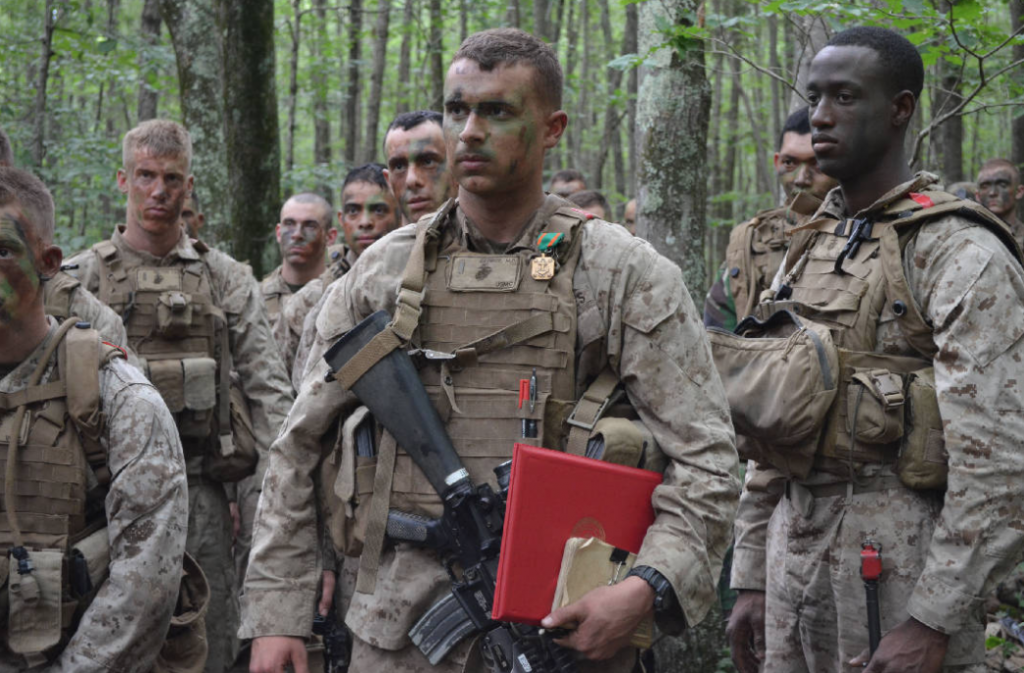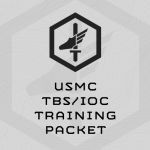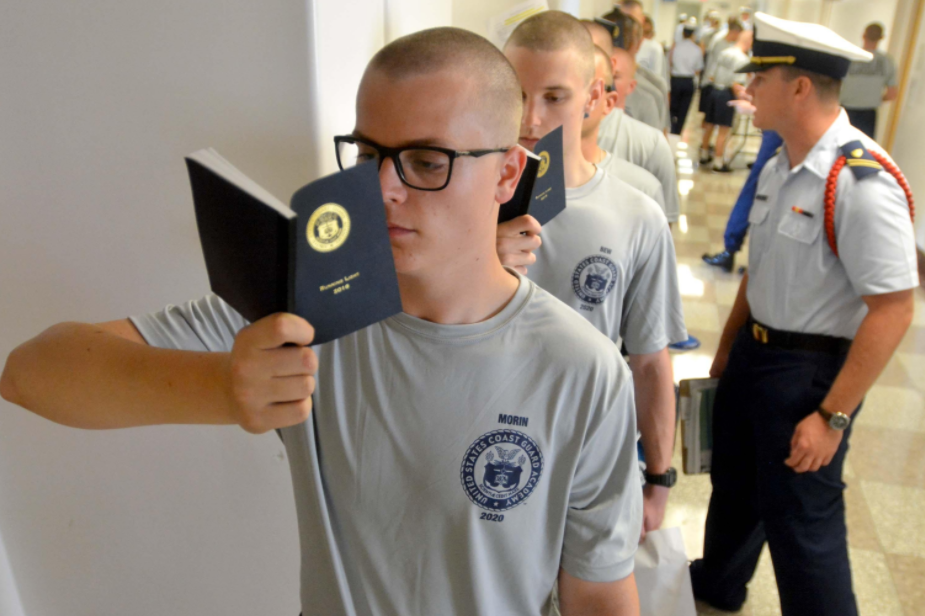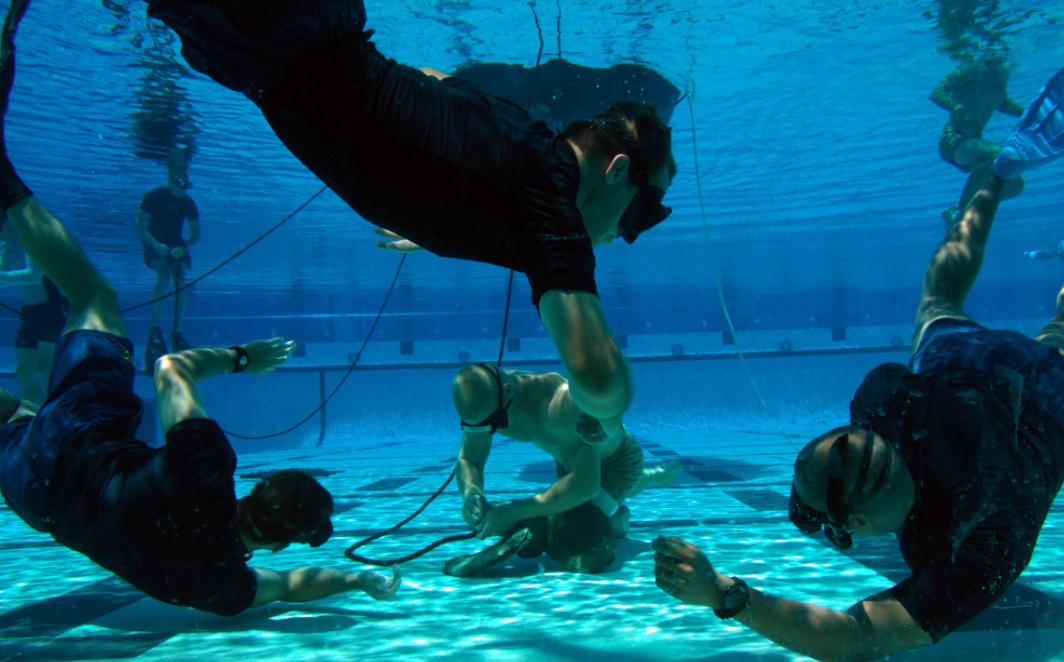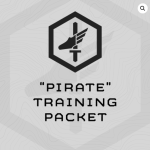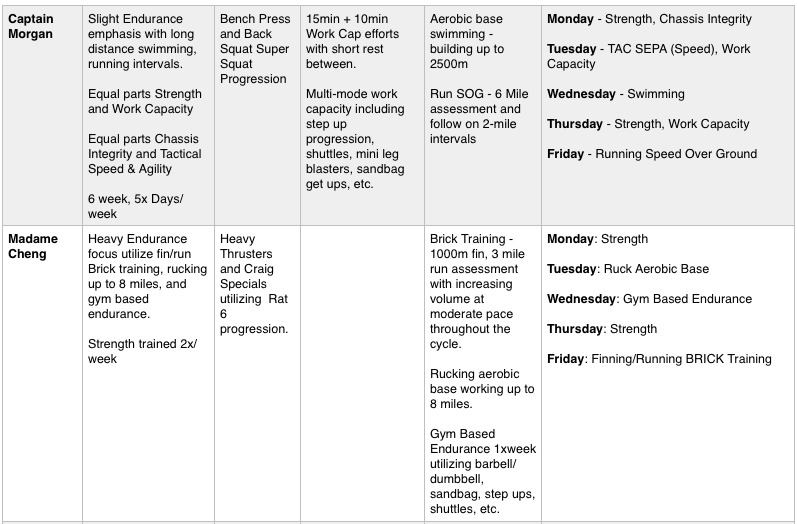KUDOS on the RAINIER TRAINING PLAN
“Thank you for your amazing Rainier Training Plan. I used it leading up to an attempt on Rainier’s Liberty Ridge. While we didn’t summit because of bad weather, I felt extremely strong and fit during the climb. The training plan did a great job of focusing on every aspect of fitness that one would need on the mountain. My 35 pound back weight didn’t even phase me. I was especially surprised and enjoyed the sandbag getups, the first few weeks they were murder, but by the end of the program I was just cranking through them.
I did find the amount of time required to be excessive, and had to add in an extra rest day each week to catch up on my “adult” responsibilities, but I’m sure other people will be able to manage.” Thanks again!
QUESTION
I have just completed valor and am wondering what program to follow next. I ship to USMC OCS in September so have about 17 weeks. I am planning on doing the USMC OCS plan immediately before shipping, what 2 should I complete in the meantime? Was thinking of doing humility & fortitude.
Also, I’ll be working through a 16 week 5k/10k running plan that was designed by a local running coach throughout this entire time (~20 miles per week, peaks at 39).
ANSWER
Watch for overtraining with your running … i.e. don’t double up. Humility’s running is loaded (25#) and Fortitude includes ruck running and unloaded running. Try to combine the running in both these plans and your running-specific plan.
You want to go into OCS fit and fresh, not fit but exhausted.
Good luck! Excited for you!
– Rob
QUESTION
I’ve been slacking pretty hard the last few months- not entirely deconditioned, but my consistency and intensity have been a lot less than “full effort” and it’s time to get back on the wagon. My goals for the rest of the year are two-fold- I want to bring my APFT score back up into the 270s (90/90/90) by my next record APFT in October (I’m in mid 70s in all three events right now), and I also want to start climbing some Class 1 and 2 14ers in NorCal toward the end of the year, with some beginner technical/ice climbing.
I’ve run your Peak Bagger plan off and on for hiking here in SoCal and I liked it, so my first thought was to just substitute Wednesday’s upper body strength with PU/SU intervals from the APFT plan, and sub the prescribed Peak Bagger runs with appropriate 800m/1mi intervals. However, I’m not sure this would be enough PU/SU training for the APFT, I’m worried it might be too much running on top of the bajillion step-ups, and I have no idea how well it will translate to my newbie mountain goals.
I also looked into doing your Ice/Mixed Climbing Preseason with some APFT supplementing, but I run into the same problem as above- my other limitation is that I don’t have any space for a systems board in my apartment. I’ve got just enough stuff for most of your limited equipment programming.
I feel like I don’t have the experience, especially on the mountain side, to know how to effectively attack these two goals side-by-side, so I figured I ought to reach out before I hurt myself or get stuck on the side of a mountain somewhere. What do you recommend?
ANSWER
There’s lots of points to consider in your note and here are some principals/thoughts I’d recommend to help prioritize your fitness training.
1) Train for the fitness demands of your tactical job first.
It’s unclear in your case if that’s LE or Military, but this should take priority as it directly relates to you and your team’s survivability. Recreational fitness and even PFT fitness should take a back seat.
2) Don’t try to train for 2 things at the same time.
Many Army athletes want to be able to score 300 on the APFT at any time, but also train for and build other fitness goals/attributes. APFT focus takes training time and can negatively impact gains in other areas – strength, rucking ability, sprinting ability, chassis integrity, etc. Why do Army members need to be primed for the APFT all the time when most know exactly when they’ll be taking the APFT? Rather than dividing training time and attention, we recommend taking 3-6 weeks directly before the APFT and focussing your programming on that event. After the assessment, move back into your other day-to-day training.
This principal holds true for mountain events/seasons also. Our Mountain Base programming concurrently trains mountain endurance (uphill movement/trail running), strength, work capacity, chassis integrity, stamina and climbing fitness. But doing our Mountain Base programming doesn’t prepare athletes for optimal performance for any mountain season/event. It lays a “base” of fitness upon which to build “sport-specific” fitness with a sport-focused plan directly prior to the event/season – for example the Peak Bagger Plan, Mixed/Ice Pre-Season Training Plan, Dryland Ski Plan, etc.
My recommendation for you?
– Train for your tactical job first. If you’re military with a known schedule for APFTs, schools, deployments, etc., and nothing is on your time horizon, it is perfectly okay to drop out of all military programming and do a sport-specific mountain-sport cycle (such as Mixed/Ice) directly prior to the climbing season to prepare, and once the season starts, drop back in to military-specific programming.
– This is more difficult on the LE side … as LE Athletes are always deployed, and face danger daily. My recommendation here is to pare back job specific programming to around 75% of your available training time and use the open 25% to train the most unique/essential components of the specific mountain activity.
For you specifically, if you’ve got a APFT coming up, complete the APFT Plan in it’s entirety and complement it with the climbing specific programming in our Mixed/Ice plan – time on the tools. Tool-specific grip strength is the key here. Second would be uphill hiking under load if you expect long approaches.
To do this effectively you’ll need a system board somewhere to train. I can’t help you with that. We haven’t found a way to train tool-specific grip strength best without system boards. We’ve done dead hangs – which are better than nothing, but not complete.
Hope this kinda helps ….
– Rob
QUESTION
I’m looking for some guidance on an upcoming training path I want to make. For a little background, I’m currently serving in the 75th Ranger Regiment with an intent on going back to college to get a Masters in the fall. I’ll be participating in ROTC when I get there (15 weeks out). I am finally in a position where I can do what I want for PT in the mornings so I grabbed an old copy of Strength and Honor that my first squad leader gave to me when he left in 2012. I’m in the last week of the Strength and Honor program and I’m searching for what to do next. I’m coming off rehab from a meniscus tear that had me out of the game for around 20 weeks. I was able to complete Strength and Honor (and feel better now than I ever did during rehab) but noticed that my conditioning was severely lacking.
Part of my ROTC requirements are monthly PT tests so I was considering starting the APFT train up 6 weeks out from school starting. I’m kind of lost as to what to do in the 8 weeks I have before I need to start that. (Probably the on ramp program but I’m seeking your advice in case there is a better option) Once I get to school, what programs should I be looking at then? I don’t want to just do the APFT train up over and over again so are there any programs that would be beneficial to the Military Athlete but also take care of that pesky PT test? I’ve already struck a deal with my liaison saying that I’m free to PT on my own as long as I score above a 290 each month so 300’s each month it is.
ANSWER
Be super diligent and never get far from APFT programming if they are facing a monthly assessment like you are.
If you are an APFT “natural” or your ROTC unit didn’t have a monthly assessment I’d recommend the training plans and order in our
Greek Hero training packet of plans, beginning with
Hector. These plans represent our most evolved military programming and concurrently train endurance (running, rucking), strength (mostly gym-based), work capacity (sprinting focus), chassis integrity (mid-section), Tactical agility and stamina. This programming is designed as the day-to-day programming for SOF personnel and other military athletes who aspire to this level of fitness.
If you are not naturally proficient at the APFT, I’d likely recommend a schedule of 2 weeks of the Greek Hero plans, 2 weeks focused APFT work directly before your assessment.
If you complete Hector, you’ll see our programming has evolved significantly from Strength and Honor.
– Rob
QUESTION
I’m an infantryman, but currently doing voluntold Drill Sergeant duty at the absolutely “wonderful” Ft Jackson. I get up every morning at 3am just so I can get an hour workout in before doing prt with the new privates. I was looking into possibly ordering your busy operator workout as I saw that it is for people like me without a whole lot of time every day, but then saw the link for grunt pt. What would be a better option for someone like me in your opinion? I don’t want to go back to the line in a year and a half and be that out of shape guy, and am looking to take over a sniper section so need to step up my game a bit. Thank you in advance
ANSWER
Grunt PT is solid, and the gym-based programming is designed to last 60 minutes. The endurance programming can run longer – depending upon how fast you can run/ruck – so you’ll have to plan accordingly.
I’d recommend starting with
Grunt PT. It’s an incredible deal and you can deploy it with your section when you finish your drill sergeant duty.
– Rob
QUESTION
This is probably a really stupid question, but when the plan uses the # sign, does that mean pounds? It confuses me since I can see kg weights, and assume lb must turn to # on my computer.
ANSWER
Yes. # = pounds, so 25# = 25 pounds.
– Rob
QUESTION
ANSWER
Best would be
Ultra Preseason with lots of hilly trail running for your long run training in the plan. You could do the same with the
50 Mile Ultra Plan though the distance there would over prepare you for your event.
The
Alpine Running plan is focused primarily on FKT efforts for extended peak bagging. It’s focus is vertical gain/loss and I’m not sure would give you the simple volume needed for your race.
– Rob
QUESTION
I recently completed the 3rd APFT in the APFT improvement plan. I showed marked improvement on sit-ups and the run but remained stagnant in push-ups (55). I’ve noticed that I typically burn out in the 5th or 6th set when completing a set every 75 seconds as the plan prescribes.
Do you have any recommendations to help me improve? I read an article posted on the site on February 12, 2016 regarding pushup improvement where multiple strategies were tested among four groups. Has there been any more research in this area?
Thanks for your time and any insights.
ANSWER
The 5th and 6th set “wall” is not unusual for push ups in this progression – what is unusual is no improvement. Everyone is different and different athletes can react different to the same programming.
Our own study was somewhat inconclusive and we haven’t conduced another recently.
Different things to try ….
– Hand width and placement
– Assessment technique …. My best score came by sprinting at first, but stopping with 5 or so reps in “reserve,” then knocking out sets of 1-2 until the time was completed
– “Grease the Groove” training… this comes from the kettlebell folks and essentially says do sets of pushus all throughout the day, but don’t come close to failure on any one set … so you might end up doing 40 – 50 sets of 5-10x push ups throughout the day.
– Other push up improvement programs … there are a bazillion other programs just for pushups a simple google search away. One might work better for you individually over our progression.
– Rob
QUESTION
I am a LEO from Melbourne, Australia, and will be undergoing selection for out Special Operations Group in approximately 12 months time.
I am seeking direction where to start with your programming.
I am happy to sign up to an athlete subscription, but I am unsure where to start from there.
I have a solid strength base, but running and endurance needs work. (Better power to weight ratio)
Which programs do you recommend I complete over the next 12 months, and in what order?
ANSWER
What do you know about the details of the selection? Duration? Major events? Is there a “gate” fitness assessment? What is the unit?
– Rob
FOLLOW UP
The unit is called the Special Operations Group (SOG), which is the spec ops/CT unit for Victoria Police.
SOG barrier test consists of
3.2km run (2 mile) in under 13:30
AMRAP Bodyweight bench press, minimum 5 reps
10 pullups
60 situps
Weighted 400m run
400 meter swim
Selection is based off our SAS selection, with alot of running, and bodyweight smoke sessions.
Partner carry drills, carrying cinderblocks at extended arm carry, 1 mile lunges, sand sprints, etc. All part of it. There is also a few large rucks done at a fast pace.
The selection course runs for 12 days.
Then there is a training cycle of 13 weeks, where there is more of a learning focus, but still numerous daily smoke checks
The selection is run much like the military, which has raised some criticism recently, as some believe its too much for a police unit.
FOLLOW UP ANSWER
12 months = 52 Weeks.
Weeks Plan
43 Total Rest
– Replace the push ups with a bodyweight bench press in the assessment and follow on progressions
– Replace the 300m sprint with a 400m loaded sprint
– drop the Ruck Assessment Distance from 12 miles to 6 miles and the follow on progressions down to 2 miles
QUESTION
I have been looking through your website and I love all of the programs that you have. Though I feel that most of it is above my skill level and I am not sure where to start, Ill explain.
I am a 68W NCO stationed overseas. Here is where combat medic skills and physical fitness take a back seat to hospital accreditations, inspections, mandatory trainings, and massive amounts of computer time and power point presentations.
My typical day is showing up to the hospital at 0700 and leaving around 1600. Which is roughly the same for many of the Soldiers and Airmen who work there as well. There is no formal PT sessions or mandatory PT. It is all on your own.
Now I understand there is an expectation of doing PT on our own, but many times it is really hard to get started after sitting in meeting after meeting or at the computer for an entire day.
Our APFT comes twice a year, April and October. You will see an increase in gym attendance and some of the craziest diets you can imagine, all two to three weeks prior to the APFT and H/W.
Sadly, I have fallen into this mind frame as well. Prior, I was in a combat arms unit and while deployed I workout out all of the time, either PT sessions or gym sessions with other Soldiers. At LRMC this is not overly possible due to hospital schedules.
Also personally for me, I do not have any Soldiers.
I just took my APFT and scored a 219. I was really tired after. Exhausted. I passed tape at 22%. I’m 32 and at 72″.
I need a program that either can be created or one already there to get a hospital worker back to higher standards of military life. Without injury as well. I see most of the programs you have are geared toward those in the field who are already in programs or in much better shape. I know that if I jumped into one of the programs, I would either hurt myself, or become depressed that I could not get through a days workout.
I would like to get a 270+ on my next APFT in October. I would like to not get taped.
Any advice would be awesome. Sorry for the long email. I just need some help.
ANSWER
This plan is designed specifically for military athletes like you.
– Rob
QUESTION
Do you have a training program for an Everest Base Camp trek?
ANSWER
QUESTION
Additionally, I must say your website is enjoyable to use.
I am doing the 3 peaks next month for the first time and wondered if you had a jacket recommendation based on a budget up to £240? Looking for a lightweight softshell, like the Rab Latok (Rab doesn’t seem to be wide enough on the shoulders for me).
eVent has been highly recommended although after reading your study Goretex may be the better option! Have you performed a secondary study yet?
If you would like to follow my hike I’ll be posting the walk on my YouTube channel (Digitally Perry).
ANSWER
I’m not a fan of softshell jackets because of their weight, and not being waterproof. Understand gore-tex, event and all the jackets we reviewed were “hardshell” and waterproof.
Also, from our study we found that the “breathable” element of all these fabrics is minimal … that’s why they all have pit zips!
In my personal kit I carry an
Outdoor Research Helium Jacket. Waterproof, and super light, bomber and relatively cheap. OR also makes a gore-tex
Foray Jacket which has been well received but is heavy at over 16 oz.
A great choice in the middle is the
Arcteryx Alpha SL. You can never go wrong with Arcteryx gear.
– Rob
QUESTION
I’m a military athlete, I work with Naval Special Warfare. I’ve had some good success, and used twice, the DG Screener Prep and also with Busy Operator.
I just bought your Greek God package today, it seems really interesting and I’m excited to get started. I just have a few questions, apologies if this info is available somewhere; I just didn’t see it.
1. Do you recommend doing these separate programs one after the other?
2. If so, is the deload already programmed, or should I just take a slow week between heroes?
3. If so, what order do you recommend I do the programs? For example Hector followed by Achilles followed by Apollo etc…
4. If not, is the best idea to pick one and repeat it, calculating a (hopefully higher) new 1RM?
5. I continue my prep for DG. I see some real potential for growth here without continuously redoing the DG program.
– Do you agree?
– Where would be best to fit in my strength endurance push ups? I have the unfortunate attribute of quickly losing my strength endurance if I do not constantly stay on top of it particularly with push ups.
Don’t mean to bug, I appreciate any guidance.
ANSWER
2. Yes. Plans are 7 weeks long and week 7 is a deload.
3.
4. See above
5. No. Best to complete the DG Plan directly before selection. The Greek Hero plans will train all important elements except swimming. We’re currently designing a packet of SOF plans for units with SCUBA and other water mission-sets … should be out soon.
6. Push Ups … work up to be able to do a deck of cards 2-3x week, in the evenings or after a regular training session. If I remember right, there are over 500 push ups in a deck. Start by turning over 2x cards … face cards count as 10x Reps. Aces count as 15 Reps – all other cards count their number. 3 of clubs = 3x reps, etc.
Start with 1/2 a deck and keep working up. With work you can get to a full deck in about 30 minutes. Rest around 30 seconds between sets.
When you can get a full deck turning over 2 cards at a time, move to 3.
– Rob
QUESTION
Two questions. I have worked through a few of your workout plans that are excellent (Valor, LEO Whiskey, etc) and I am wondering about right progression. You usually suggest 25# dumbbells for the men… is that ever subject to change? I know you are concerned about muscle that does not benefit out in the field, but I just wanted to know if this is something that should never change, or if it can vary from person to person. Same would go with other weights recommended in the progr3ams as you progress through the sessions.
My second question is about running. I have a lot of concrete and roads where I live (I workout in my garage) which means most of the running I do (sprints, or a few miles) might be considered high impact. Have you seen any damage done by doing this over a long period of time?
Thank you Rob,
ANSWER
1. I’m assuming you’re referring to most warm up and specific exercises like Scotty Bobs, Renegade Man Makers, etc. You can increase if you like, but we’ve found 25# for men to be solid for these exercises. I wouldn’t go much above 35#.
Our strength circuits deploy scaled loading – so it automatically adjust to your strength level.
We do prescribe loading for the work capacity efforts. Don’t adjust the prescribed loading … this isn’t crossfit and our focus here is work capacity, not strength.
2. No. But we do recommend
Hoka One One running shoes because of their awesome cushioning.
– Rob
QUESTION
I am starting week 6 of Fortitude tomorrow. Loving this plan, seen some significant improvement thus far, however, there are a few areas I could use a little bit of work. I’d like to get my APFT scores up. What would you recommend doing, in conjunction with Fortitude, to improve calisthenics/running speed?
ANSWER
– Rob
QUESTION
Rob, currently doing BWF. Can I train grip strength on the side? I need more than the program is giving me. Thank you.
ANSWER
Sure. We’ve had success with heavy farmer carries for time – 75# plush dumbbells or a 60# sandbag. Increase the time as you get stronger.
– Rob
QUESTION
Hey Rob…need a decent starting point…you have a LOT of training options. I’m 55 and wanting to get back into fighting shape. I had a spinal fusion in 1999 and have neuroforamianl narrowing (means I get some nerve stuff into my legs sometimes). I’m not asking for medical advice but am thinking back squats and/or deadlifts might not work. I can do deads off a rack and feel comfortable doing front squats and/or lunges. Anyway, I need to get strong again, and at the same time, be able to function, move, and do what I need to do…including Spartan races. I appreciate your advice. I had a previous subscription but thought I’d wait until I had my MRI. Basically, the MRI said what it always says so I’m ready to get going.
ANSWER
– Rob
QUESTION
Just purchased the Bodyweight Foundation package and look forward to getting started Monday. Quick question on a substitute for one of the exercises as I’m trying to avoid doing sit-ups based on previous back issues. Is there anything specific you recommend I do instead of Sit-ups?
ANSWER
QUESTION
I know the Grunt PT scheduling is designed for the line and your Greek Hero
series is designed for SOF personnel. I want to get myself to an SOF
standard of fitness, but I am just a grunt in the line.
If I follow the Grunt PT scheduling am I limiting myself to lower
standards?
ANSWER
The equipment and scheduling issues of line unit reality constrain
somewhat the exercise and programming flexibility I have with Grunt PT
(www.gruntpt.com).
But it’s wrong to think this programming is as well thought out,
mission-direct and effective as our Operator Sessions.
Grunt PT is designed for enlightened line unit military leaders at all
levels – Squad leaders and up, who are not satisfied with the drudgery
and mission-direct limitations of regular PT, institutional inertia
and understand that they are also responsible for their subordinates’
physical preparedness.
Grunt PT is an affordable, sharpened tool they can implement
immediately with their team if they have some equipment
resourcefulness and fitness insurgent approach.
– Rob
QUESTION
I am writing to you to ask for advice. I have finished the whole Ruck Based Selection training plan and swim improvement training plan, which I have bought from you last year.
Unfortunately, my selection has been postponed due to my posting abroad and finishing the Military Academy. I will attend the last ruck-based selection phase (6 days in the mountains) in October/ November 2017. I am a little bit confused on what to do now (which plan should I stick to). I have between 20 and 24 weeks until the selection takes place.
Due to small amount of time in next 6 weeks i was thinking about such training cycle:
1. Weeks 1-4 Run Improvement Training Plan + Bodyweight Training Plan (Bodyweight training after running?)
2. Weeks 5-6 + 2 more weeks after graduation- Swim Improvement Training Plan + Ruck Improvement Training Plan + Core focus
3. 12-16 weeks left…. no idea what than?
What do you think about it? I have also Gymnastic Rings and Kettlebells (2x 16kg, 1x 24kg) which i can use. The only possibility to train for me is my room, swimming pool and running inside the unit. There is no possibility for training in the gym right now. I struggle to sleep 6-7h due to huge workload, that is why i cut the time on driving to the gym and back (~45’up to 1h).
Sorry for my poor language skills.
ANSWER
You want to repeat the 8-week Ruck Based Selection Training Plan directly before selection … so work back from there. Also – you don’t want your training to get stale.
Here’s what I recommend:
Weeks Plan
8 Week Total Rest
– Rob
QUESTION
About 9 months ago I hurt my wrist olympic lifting, but was never able to really rest it or get treated due to a deployment, training for Ranger School, and Ranger School (I was successful). I was finally able to confirm that I tore several ligaments in my wrist, and though I’m still waiting on the final verdict for treatment, I will almost certainly be sidelined from using my right wrist seriously for 4-6 months.
I am a Platoon Leader in the Regular Army (Stryker unit) so I need to preserve my abilities as a tactical athlete, but plan to take a step back from my regular Crossfit heavy schedule and re-focus on triathlons and distance (1/2 and Full Marathon).
What is the best plan(s) or plan pack to focus on endurance and that avoids (or is easily scaled to avoid) two arm or wrist heavy movements (even burpees are very hard on my wrist).
ANSWER
I’d recommend Humility with common-sense exercise substitutions.
For push ups and pull ups use dumbbell bench presses and 1-arm Bent-over dumbbell rows. For the assessment use a 35# dumbbell.
For the dumbbell strength work in the plan, use a dumbbell in your good arm.
You should be good with the running and IBA runs in the plan.
– Rob
Subscribe to MTI's Newsletter - BETA

